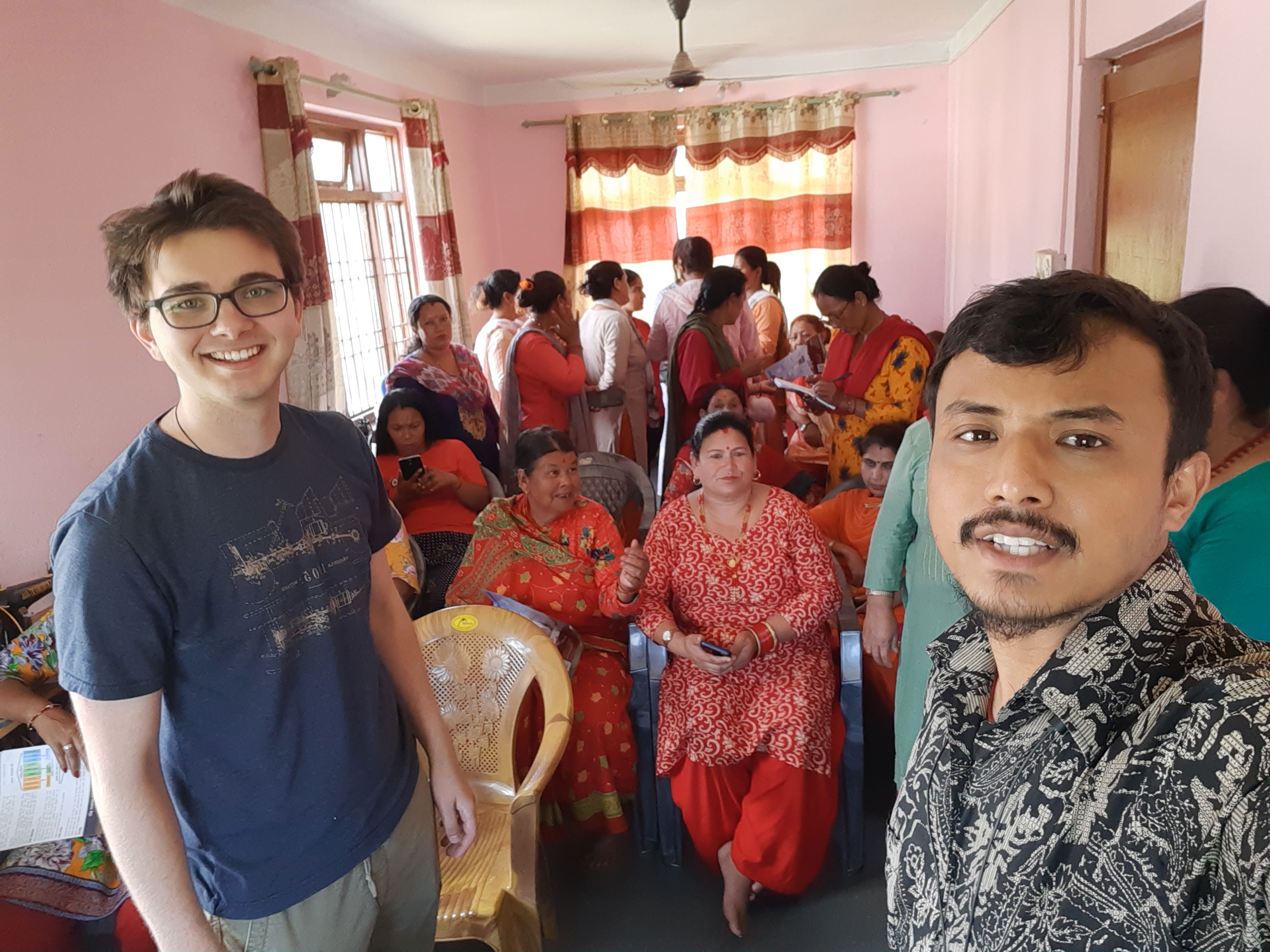One Step at a Time
आषाढ़ ३१, २०७९ | Tejas Nenneman ( Minnesota, USA )

The day after rice planting, my Supervisor, Bobin, and I went to Kageshwari Manohara, Kathmandu district. My task was to observe and assist Bobin in the information session taking place. Since the main objective that GeoKrishi has is getting Nepali farmers to use ICT technology, GeoKrishi is helping bridge the gap between what farmers have, and what ICT technology can provide them with. To help bridge that gap, GeoKrishi goes directly to the farmers and assists them in setting up the GeoKrishi App. Since a key problem that Nepali farmers have with ICT technology is the lack of services geared towards them, GeoKrishi helps by showing how to use and access their services, right at their doorstep.
Upon arriving, we entered the local Government Municipal building. My supervisor explained that this building was used for more than just small government work, it was also used as a meeting place for locals to gather and talk about everyday life, from the simplest of issues to the biggest of problems. This was also the building we were going to use to help assist the farmers in their plight to use the GeoKrishi App. After hiking up steep stairs, we entered a reasonably large room ideal for lectures. Chairs were spread out in neat, orderly rows and columns. To the right of the room was a large desk that my supervisor and I sat behind. Just as I began to sit down, the room began filling up with farmers, many more than I had thought would arrive. Bobin wasted no time, and began by introducing himself, and beckoned for me to do the same. After the introduction, the farmers did the same, each and every one of them introduced themselves to us and their fellow farmers. By this time more chairs were added into the room to accommodate three more farmers, two of which sat directly to my right. Over the course of the day, I would try my absolute best to help them use the app, even with the language barrier. After the greetings had finished, Bobin instructed me to get a hotspot for the farmers to have access to wifi in the building. After buying an unlimited access hotspot for two hours, I helped set up the farmers’ phones and connected to the app store to download GeoKrishi farm. Many of the phones had cracks, and some simply wouldn’t connect to the hotspot until the fourth or fifth time. Unstable wifi and data are one of the many problems that farmers must go through even before accessing the app. Although this problem is being fixed in the status quo, it’s still one of the many hurdles that farmers must go through to even consider using ICT technology. Moreover, farmers also have to deal with energy shortages. Data isn’t always cheap either, and it’s not always accessible. The next task was downloading the GeoKrishi Farm app, which Bobin would explain to the farmers how to use. Even though the app is supposed to be accessible, there was still general confusion for some of the farmers after downloading it. Logging in proved to be a challenge for some of the farmers, and sometimes navigating the interface proved to be a challenge for the farmers while Bobin was providing information on the app, and the many uses it had. There was a slight learning curve for many of the farmers, and some didn’t understand the layout of the interface during the beginning. After being asked about where some of the features were on the interface in Nepali, I asked my supervisor, Bobin, to help the farmer out, and to make sure that she understood what section of the app Bobin was presenting. I also downloaded google translate to reduce the language barrier too. Although it wasn’t perfect it did help me solve some of the questions that the farmers had instead of asking Bobin all the time. Gradually though, through the course of the first hour and a half, the farmers started to get a hang of the technology, and where certain features were located on the interface, like the location of the livestock category and how to find the specific animal, such as a chicken or pig that they were looking for.
After the lecture, it was time for the farmers to start asking questions about the technology, and problems that they were facing. I wasn’t able to understand most parts of the conversation, but Bobin wrote down many of the issues that they were facing. Just then two women from the back of the room migrated towards the front of the room. Bobin informed me that these women were working with an organization like GeoKrishi, and asked to watch how Bobin and GeoKrishi use, and implement technology to help solve the many problems that farmers have. Bobin began writing down many of the problems that the farmers were having, key problems included issues with transporting crops to market, the lack of fertilizer available to many of the farmers, not enough technicians or none at all, and poor support with subsidies from the Nepali government. The problems that Nepali farmers have are vast, but with the support of organizations like GeoKrishi, progress is being made. So far, GeoKrishi has helped more than 30,000 farmers and aims to only expand that reach. The road to progress is paved with many challenges, both for the farmers and those at GeoKrishi, but the only way forward is to listen to farmers and help them out, one step at a time.